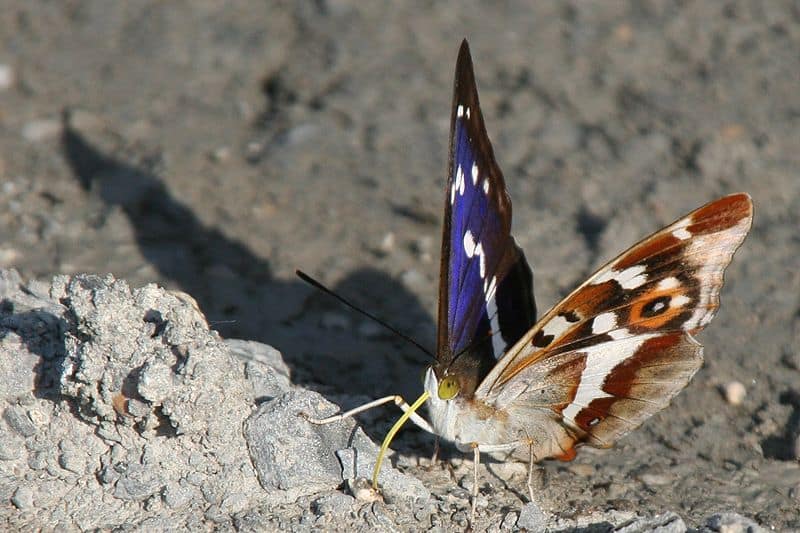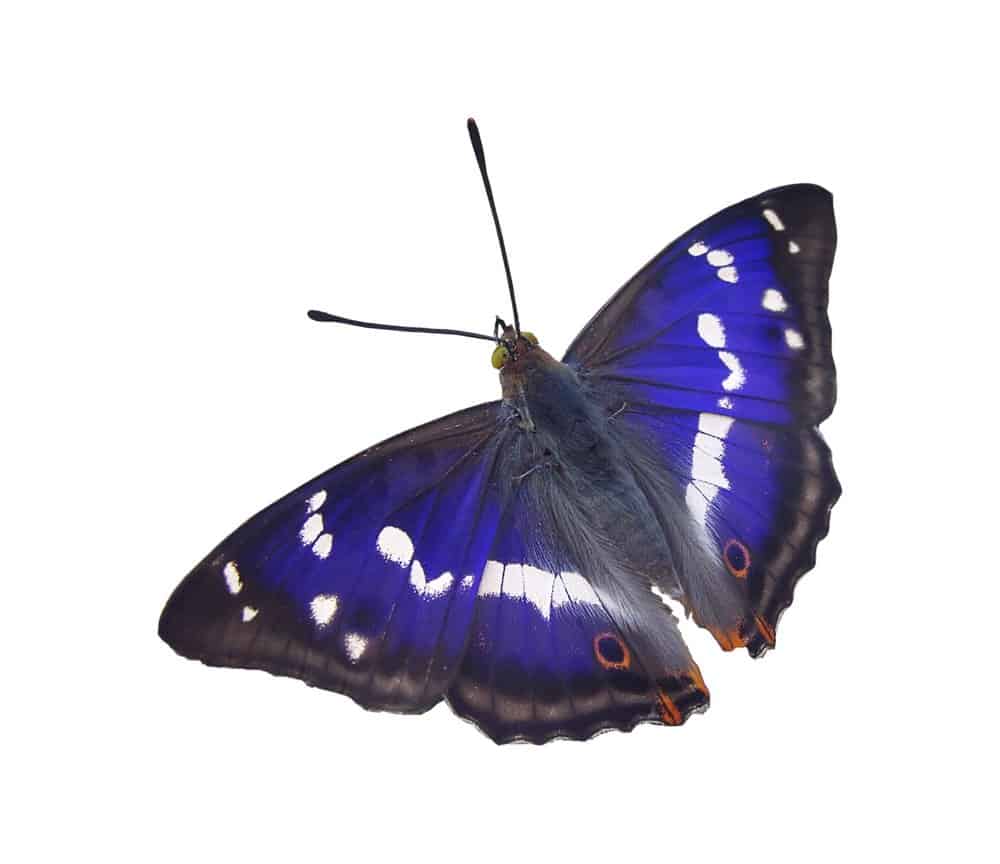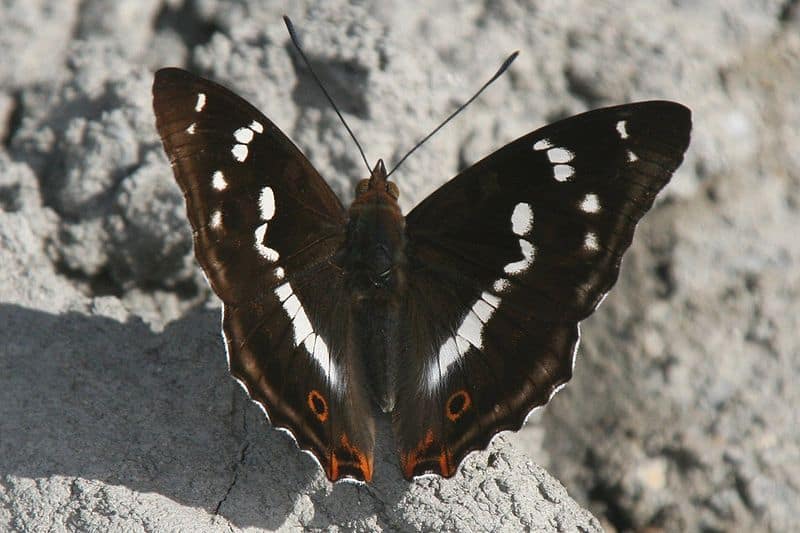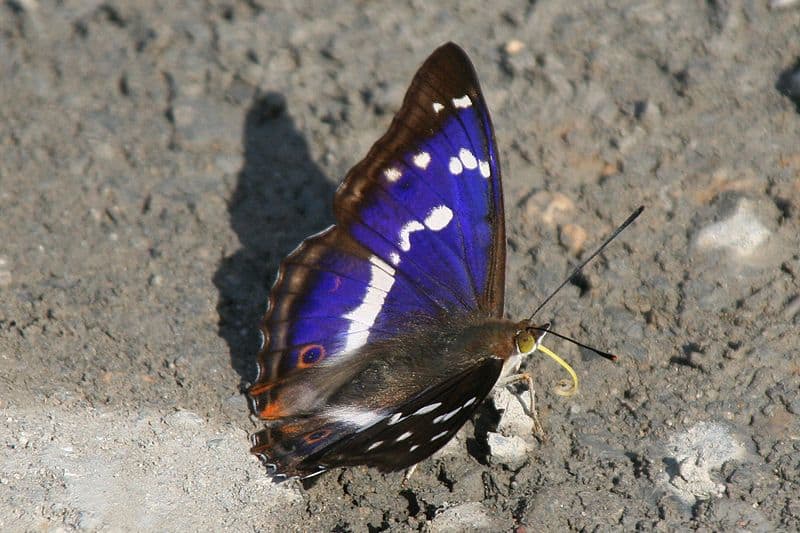Purple Emperor Butterfly
Apatura iris
Inhabits deciduous forests!
Advertisement
Purple Emperor Butterfly Scientific Classification
- Kingdom
- Animalia
- Phylum
- Arthropoda
- Class
- Insecta
- Order
- Lepidoptera
- Family
- Nymphalidae
- Genus
- Apatura
- Scientific Name
- Apatura iris
Read our Complete Guide to Classification of Animals.
Purple Emperor Butterfly Conservation Status
Purple Emperor Butterfly Facts
- Average Litter Size
- 100
- Favorite Food
- Larvae
- Common Name
- Purple Emperor
- Number Of Species
- 1
- Location
- Britain and Europe
- Slogan
- Inhabits deciduous forests!
View all of the Purple Emperor Butterfly images!
The Purple Emperor is a large butterfly whose males have areas of iridescent purple on their wings.
The larger females do not have this iridescence, which is how the sexes can be told apart. Its numbers are declining largely due to habitat loss, as the sallow or willow trees where they lay their eggs and the broadleaf trees where they live are being cut down.

5 Incredible Purple Emperor Facts!
- The Purple Emperor is a Palearctic butterfly, which means it’s found in Europe and Asia to the Himalayan foothills and in North Africa. The Palearctic realm is the largest of the ecological realms on earth.
- It belongs to the genus Apatura. Most of the butterflies in this genus are known as Emperors.
- Purple Emperors lay their eggs on the leaves of sallows, or willows, especially Goat and Gray willows. Occasionally, they’ll lay their eggs on poplar trees.
- The Purple Emperor is the second-largest type of butterfly. Only the Swallowtails are larger.
- The Purple Emperor’s conservation status is Not Threatened, even though its numbers are declining. It’s also protected under the Wildlife and Countryside Act of 1981.
Species, Types, and Scientific Name
The scientific name of the Purple Emperor is Apatura iris. Apatura is probably from the Greek word Apaturia, which means “the deceitful one” and was used to describe several goddesses. The word probably refers to the deceptive nature of the male Purple Emperor’s wings, which only show their iridescence under the right conditions. The other half of the butterfly’s scientific name, Iris, refers to the Greek goddess of the rainbow.
There are five known subspecies of Purple Emperor. They are:
- Apatura iris iris
- Apatura iris bieti
- Apatura iris xanthina
- Apatura iris kansuensis
- Apatura iris amurensis
Evolutionary and Origins

Purple Emperors have adapted unique camouflage over their history.
©Rosenzweig / Creative Commons
The purple emperor butterfly, also known as Apatura iris, has a fascinating evolutionary history that has been studied extensively by scientists and researchers. It is believed that this species of butterfly first originated in Europe and Asia, with some populations spreading to other parts of the world over time.
One interesting aspect of the purple emperor’s evolution is its unique coloration. The distinctive iridescent blue-purple hue on its wings is thought to have evolved as a form of camouflage or visual deception, helping it blend in with its surroundings and avoid predators.
Another important factor in the purple emperor’s evolution has been selective breeding. Over many generations, individuals with desirable traits such as strong flight abilities or better camouflage have been more likely to survive and pass on their genes to future generations.
Appearance: How To Identify Them

Purple emperor butterflies are between three and three and a half inches long
©Marek Mierzejewski/Shutterstock.com
The wings of the Purple Emperor have a pattern of whites and shades of dark brown. Each hindwing has an eyespot of black, purple, and orange. The underside of the wings of both males and females are different shades of brown marked with white. Males are a bit smaller than females, with a 2.8 to 3-inch wingspan. The wingspan of the females is 3.15 to 3.54 inches.
The eggs are green or yellow and can be found on the top of sallow leaves. They usually hatch after two or three weeks.
The caterpillars are green with white stripes and dots. They molt or shed their skin five times before they pupate, and during their second molt, they develop horns on their head that make them resemble bright light green slugs. At night they eat the leaves of the willow where they were hatched. It takes about 10 months for the caterpillar to become fully grown, and that often means that they need to hibernate over the winter. A fully grown Purple Emperor caterpillar can be between 1.37 and 2.2 inches long.
When the caterpillar is ready to hibernate, it stops eating, turns brown, and shelters in the fork of a branch. When it wakes up, it starts to eat again, sheds its skin one more time then crawls up to the very top of the tree to pupate. There it creates a chrysalis that is between 1.18 and 1.38 inches long and 0.47 to 0.59 inches wide. It is camouflaged as a willow leaf.
The adult finally emerges in July and has a six-week life span.
Habitat: Where to Find Them

©Stanislav71/Shutterstock.com
The main species of the Purple Emperor seems to be concentrated in several areas in England, especially the forests of southern England. This is where willows and other broadleaved trees are found. Some specimens have also been found in Monmouthshire in Wales.
Subspecies of the butterfly are found in Eurasia. Apatura iris bieti is found in central and western China as well as Tibet. Apatura iris amurensis can be found around the Amur and Ussuri Rivers. The Amur River is the border between Russia and Inner Manchuria, and the Ussuri River runs through Russia and northeastern China.
Behavior

Purple Emperors use pheromones to attract a mate.
The purple emperor butterfly, also known as Apatura iris, is a majestic species with captivating behavior that has been the subject of numerous studies. These butterflies are found in woodlands and forests across Europe and Asia, where they spend most of their time flying high up in the tree canopy.
One notable aspect of their behavior is that they are highly territorial creatures. Males will fiercely defend small territories against other males to attract females for mating purposes. They use pheromones to detect each other’s presence and engage in aerial battles to establish dominance.
Purple emperors are also known for their unique feeding habits. Unlike many other butterfly species that feed on nectar from flowers, these butterflies prefer to feed on sap from trees or rotting fruit on the forest floor. This adaptation allows them to thrive in woodland habitats where flower resources may be limited.
Another fascinating behavior exhibited by purple emperor butterflies is their use of camouflage when resting on tree trunks or branches. The underside of their wings resembles bark or leaves, making it difficult for predators such as birds and lizards to spot them.
Diet

Purple Emperors eat leaves
The Purple Emperor caterpillar eats the leaves of the sallow tree. The butterfly is unusual in that it doesn’t sip nectar from flowers but takes nourishment from tree sap, the honeydew produced by aphids, and the moisture and salt produced by excreta and dead animals. Purple Emperors are so attracted to dead things that collectors used decaying animal carcasses to bait them, and the males sometimes get run over when they visit roadkill.
Predators and Threats

Purple Emperors face numerous threats to their survival.
The purple emperor butterfly, like many other species in the animal kingdom, faces numerous predators and threats that endanger its survival. Among its most significant natural predators are birds such as woodpeckers, jays, and cuckoos. These birds prey on the butterfly’s larvae or pupae by using their sharp beaks to extract them from their hiding places.
Other than bird predation, habitat loss is also a major threat to the purple emperor butterfly’s population. The destruction of forests and woodland areas where these butterflies typically reside has drastically reduced their numbers over recent years. This is due to deforestation activities that destroy trees where they lay eggs or feed on sap.
Furthermore, climate change poses another challenge for this species since it affects weather patterns leading to unpredictable conditions detrimental to the butterfly’s life cycle stages. Extreme heat waves can dry up habitats, while sudden temperature drops can kill off larvae before they develop into adults.
Reproduction, Life Cycle, and Lifespan

Purple emperor butterfly court each other with a complicated fluttering of wings.
©Massimiliano Paolino/Shutterstock.com
The purple emperor butterfly has a fascinating life cycle that involves four distinct stages. The first stage is the egg, which is laid by the female butterfly on the leaves of host plants such as willow or sallow. These eggs hatch into larvae or caterpillars, which go through several molts and shed their skin to grow larger.
After feeding on leaves for several weeks, the larva forms a pupa or chrysalis, where it undergoes metamorphosis and transforms into an adult butterfly. This process takes around two weeks before emerging from its cocoon as a fully-formed butterfly.
In terms of reproduction, male purple emperors are known for engaging in territorial behavior during mating season. They perch high up in trees and chase away rival males while waiting for females to come within range. Once they spot a potential mate, they fly down to her and engage in courtship rituals such as wing fluttering and pheromone release.
The lifespan of purple emperor butterflies varies depending on factors such as climate conditions and predation risk. However, most individuals live for around one year from egg to adult emergence. Overall, these beautiful insects have captured our imaginations due to their striking appearance and intriguing life cycle behaviors that make them stand out among other species of butterflies.
Population and Conservation

Habitat loss is threatening the survival of the purple emperor butterfly.
©KRIACHKO OLEKSII/Shutterstock.com
As butterfly enthusiasts, it is crucial to understand the population and conservation status of the purple emperor butterfly. The purple emperor butterfly is a rare and elusive species that inhabits deciduous woodlands across Europe, including the UK. Despite their beauty and unique behavior patterns, little is known about their current numbers or distribution.
The conservation status of the purple emperor butterfly remains uncertain due to insufficient data on its populations. However, several organizations have been actively monitoring these butterflies in recent years to gain more information about their population trends and assess potential threats.
One significant threat to this species survival is habitat loss caused by deforestation and land development for agriculture or urbanization purposes. Other factors include climate change, pesticide use, invasive species introduction, and overcollection for commercial purposes.
View all 192 animals that start with PPurple Emperor Butterfly FAQs (Frequently Asked Questions)
Are Purple Emperor Butterflies herbivores, carnivores, or omnivores?
Purple Emperor Butterflies are Omnivores, meaning they eat both plants and other animals.
What Kingdom do Purple Emperor Butterflies belong to?
Purple Emperor Butterflies belong to the Kingdom Animalia.
What phylum to Purple Emperor Butterflies belong to?
Purple Emperor Butterflies belong to the phylum Arthropoda.
What family do Purple Emperor Butterflies belong to?
Purple Emperor Butterflies belong to the family Nymphalidae.
What order do Purple Emperor Butterflies belong to?
Purple Emperor Butterflies belong to the order Lepidoptera.
What genus do Purple Emperor Butterflies belong to?
Purple Emperor Butterflies belong to the genus Apatura.
Where do Purple Emperor Butterflies live?
Purple Emperor Butterflies live in Britain and Europe.
In what type of habitat do Purple Emperor Butterflies live?
Purple Emperor Butterflies live in deciduous woodlands.
What do Purple Emperor Butterflies eat?
Purple Emperor Butterflies eat larvae, sap, and dung.
What are some predators of Purple Emperor Butterflies?
Predators of Purple Emperor Butterflies include bats, frogs, and birds.
What are some distinguishing features of Purple Emperor Butterflies?
Purple Emperor Butterflies have long, curled tongues and brightly colored wings.
How many babies do Purple Emperor Butterflies have?
The average number of babies a Purple Emperor Butterfly has is 100.
What is an interesting fact about Purple Emperor Butterflies?
Purple Emperor Butterflies inhabit deciduous forests!
What is the scientific name for the Purple Emperor Butterfly?
The scientific name for the Purple Emperor Butterfly is Apatura iris.
How many species of Purple Emperor Butterfly are there?
There is 1 species of Purple Emperor Butterfly.
Is the Purple Emperor dangerous?
The Purple Emperor is not at all dangerous to humans, but it is rather fearless. Males will see off birds of all sizes, including herons, from their territory.
What is a Purple Emperor?
The Purple Emperor is a type of butterfly. Besides the genus Apatura, it belongs to the family Nymphalidae, a huge family that contains 6000 species of butterfly.
Where can I see Purple Emperor butterflies?
Since Purple Emperor butterflies live in the canopies of forests, they are somewhat hard to see unless the person is patient. The best places to see them are areas in England such as the West Country, Fermyn Woods, Bently Wood and the western Midlands. Known as a strong flyer, the butterfly appears as black with white markings and can be as large as a small bat. Powerful binoculars are a must to catch a glimpse of this insect.
A person who doesn’t want to spend hours trying to spot this butterfly in the wild can see them in places such as Next Door Zoo.
How do you attract the Purple Emperor?
One way to attract a Purple Emperor is to prepare a place in a garden and, frankly, add decaying meat or something equally putrescent. A less off-putting way to attract the butterfly is to plant stands of sallow trees where the females can lay their eggs.
How much does a Purple Emperor sell for?
Given their elusiveness, Purple Emperor butterflies are probably not for sale. It has been placed on Schedule 5 of the Wildlife and Countryside Act of 1981 which means it must not be captured, injured, or killed.
How many legs does the Purple Emperor have?
Like most insects, the Purple Emperor has six legs. They are connected to the thorax, which is the middle part of the body between the head and the abdomen.
What do Purple Emperor caterpillars eat?
The Purple Emperor caterpillars eat the leaves of the tree upon which they were hatched, which is most often the leaves of sallow, or willow trees. The butterflies take in sap and the secretions from aphids, rotting carcasses, feces, and urine.
How do Purple Emperor Butterflies have babies?
Purple Emperor Butterflies lay eggs.
Thank you for reading! Have some feedback for us? Contact the AZ Animals editorial team.
Sources
- Next Door Zoo, Available here: http://nextdoorzoo.com/2015/05/30/purple-emperor/
- Wikipedia, Available here: https://en.wikipedia.org/wiki/Apatura_iris
- Discover Wildlife, Available here: https://www.discoverwildlife.com/animal-facts/insects-invertebrates/facts-about-purple-emperor-butterflies/
- Butterfly Conservation, Available here: https://butterfly-conservation.org/butterflies/purple-emperor
- Game and Wildlife Conservation Trust, Available here: https://www.gwct.org.uk/wildlife/species-of-the-month/2020/purple-emperor-butterfly

















